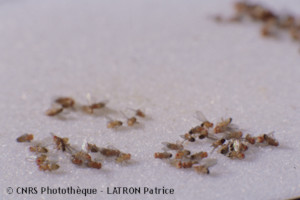Generalities
The dipterous insect fruitfly Drosophila melanogaster is one of the most important model organisms, particularly for genetics and developmental biology.
Due to its great genetic similarities with humans, fruitfly is also used as a model for human diseases, such as Parkinson’s or Huntington’s disease.
The advantages of this model are numerous: the fruit fly is a small animal with a short life cycle (thus easy to maintain in large numbers), and many mutants are available. In addition, its compact genome was one of the first genomes to be fully sequenced.
Reproduction
Drosophila can breed all year round.
Lifecycle: two weeks at 25°C, four weeks at 18°C.
Females can lay up to 400 eggs.
The larva emerges from the egg after 24 hours, grows for five days and moults twice (24 and 48 hours after hatching).
The larvae are encapsulated in the puparium where they metamorphose into adults in 5 days.
Tools
- FLP-FRT recombination: the Flippase enzyme recognizes FRT (Flippase Recognition Target) sites and performs recombination between these two sites. This technique makes it possible to obtain somatic mutations (recombination can be limited to a particular cell type or organ).
- Various wild and mutant lines available on different databases (regularly updated)
- Production of transgenic lines (by conventional technique or by germline transformation via the transposable P element).
- Targeted expression of heterologous genes
- RNAi
Databases
Infrastructures
- Plateforme de transgenèse FLY-FACILITY
- Clermont-Ferrand
- Newsletter - french laboratories working on Drosophila
- drosofrance@listes.upmc.fr
Experts
- Christophe JAGLA
- christophe.jagla@uca.fr
- UMR 6247/UMR 931 CNRS/Inserm/UdA/UB, Clermont-Ferrand
